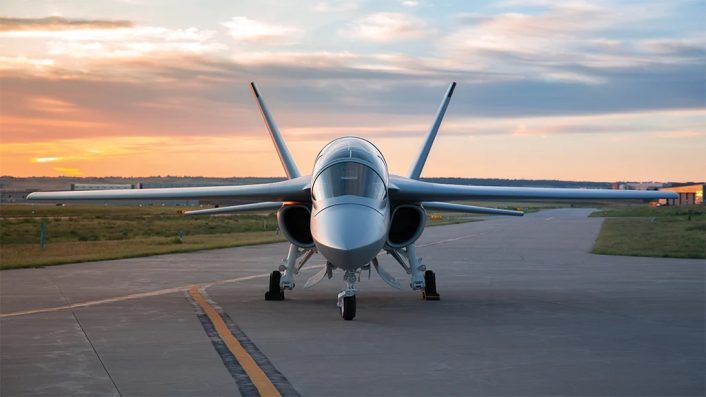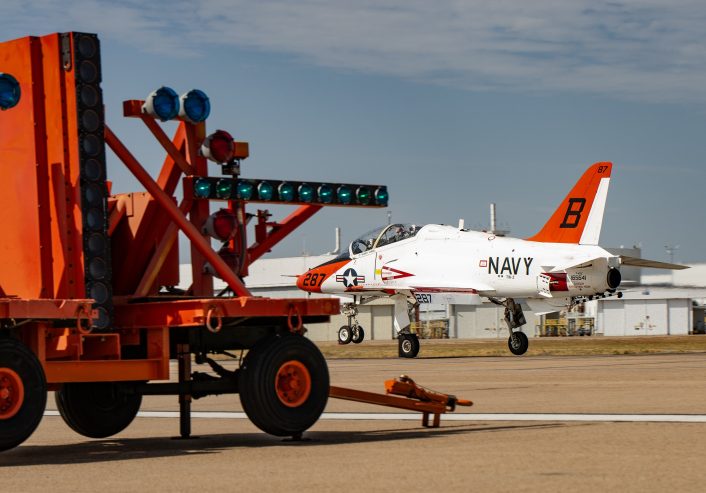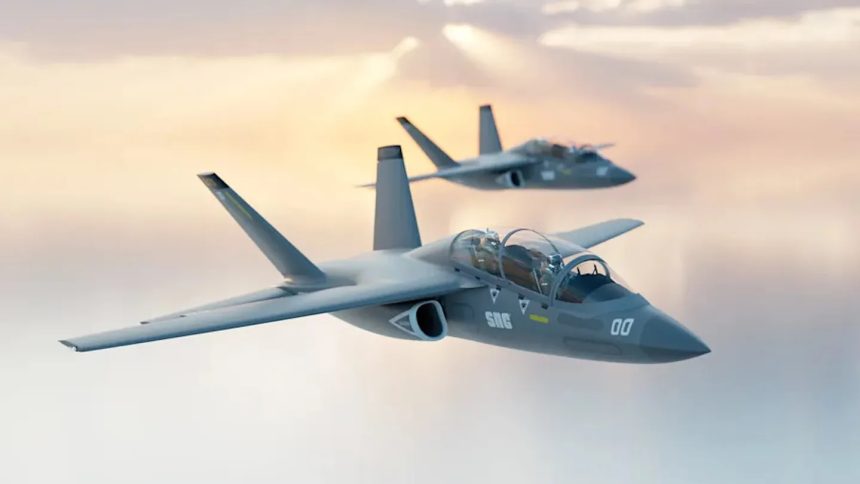Sierra Nevada Corporation unveils its clean-sheet Freedom Trainer for the Navy’s UJTS, emphasizing carrier training, cost efficiency, and digital design.
Sierra Nevada Corporation (SNC) has formally entered the U.S. Navy’s Undergraduate Jet Training System (UJTS) competition with its newly unveiled Freedom Trainer, a clean-sheet, purpose-built aircraft designed to replace the aging Boeing T-45 Goshawk. Revealed at the 2025 Tailhook Symposium in Reno, Nevada, the jet introduces a fresh competitor into what is already a crowded field that includes the Boeing T-7A Red Hawk, Lockheed Martin/Korea Aerospace Industries T-50N, and Beechcraft M-346N.
The company frames its offering as a solution with “zero compromise,” combining modern performance, low lifecycle costs, and robust carrier-representative landing capabilities—features that distinguish the design in a program that has seen shifting requirements from the Navy.
A Clean-Sheet, Purpose-Built Trainer
According to SNC’s press release, the Freedom Trainer is the centerpiece of the company’s new Freedom Family of Training Systems, developed specifically with naval aviation in mind. The aircraft features a tandem two-seat cockpit with Martin-Baker Mk18 ejection seats, and an advanced modular open systems architecture designed to ease integration of future upgrades. SNC emphasizes that the U.S. Navy would own the digital design data package, ensuring long-term control over modifications.

Unlike its competitors, which are adapted from existing trainer designs, Freedom is a clean-sheet twinjet. According to Aviation Week, which interviewed the company’s officials, Freedom was initially designed for the U.S. Air Force’s T-X program, while ensuring that it would be fully capable to satisfy Navy requirements for carrier operations.
The publication further notes that the aircraft will be powered by two Williams International FJ44-4M turbofans, each producing 3,600 lb of thrust. This configuration sets it apart from the single-engine T-7 and T-50, powered by the GE Aerospace F404, while also contrasting with the larger twin-engine M-346N, powered by the Honeywell-ITEC F124.
SNC says this approach yields significant savings, with a projected flight hour cost of around $4,500, about half that of aircraft powered by the F404 or F124. The company argues that business jet-derived engines, already in wide commercial use, promise greater reliability and lower overhaul expenses compared to traditional fighter engines.
Carrier-Representative Training Capabilities
A major point of distinction is the Freedom Trainer’s ability to perform carrier touch-and-go landings and Field Carrier Landing Practice (FCLP) to touchdown, capabilities SNC has repeatedly emphasized. The company highlights a reinforced trailing-link landing gear and a 16,000-hour service life airframe, allowing the jet to withstand the stresses of repeated carrier-style landings.

This feature is noteworthy because the Navy has moved away from requiring FCLP-to-touchdown in the UJTS program. In fact, in March 2025, the service announced that FCLP would be required only to the point of wave-off, with virtual training systems filling the gap. The Navy also previously dropped the requirement for actual carrier landings, citing cost and complexity.
Despite this shift, SNC argues that retaining the ability to conduct authentic carrier-representative training provides the Navy with flexibility, should requirements change again in future, even after the fielding of the new aircraft. “It is important to the Freedom Team that the U.S. Navy has an option to continue its essential FCLP training and avoid the unnecessary risk and cost associated with foregoing that requirement,” the company told Aviation Week.
This is in direct contrast with the other competitors, which would require significant redesign to meet carrier landing stresses. In fact, in addition to a tail hook and catapult launch bar, the structural design would need to be revised to account for the stresses of carrier operations.
Cost, Efficiency, and Lifecycle Advantages
Alongside its carrier training credentials, SNC emphasizes the aircraft’s projected affordability. The company claims 40% lower engine-related expenses than the T-45 and half those of comparable land-centric trainers. With a 16,000-hour structural lifespan, the jet is designed to avoid costly mid-life extension programs.

SNC also points to extended mission endurance, with sortie durations 30–40% longer than current Navy trainers. Longer flights mean more training time per sortie and potentially fewer aircraft required to meet the Navy’s syllabus. The service is already looking at a minimum of 145 aircraft to replace about 220 T-45s.
In interviews with Breaking Defense, SNC officials said the design was “harmonized around” the Williams International powerplant and intended to balance higher performance with significant cost savings. “What we set out to do was to be able to improve the training performance and quality while reducing the cost,” explained Derek Hess, SNC’s vice president of business development.
A Family of Training Systems
Beyond the aircraft itself, SNC envisions Freedom as part of a comprehensive training ecosystem. The Freedom Family of Systems would include the jet, ground-based training systems, logistics support, and integration with emerging technologies. For example, SNC has partnered with Red 6 to incorporate the Airborne Tactical Augmented Reality System (ATARS), a helmet-mounted display providing pilots with virtual adversaries during training.
This integration reflects the Navy’s stated desire for advanced simulation and networked training capabilities, as outlined in recent UJTS documents which mention the requirement for Live/Virtual/Constructive (LVC) integrated training. Vice Adm. Daniel Cheever, Commander of Naval Air Forces, has emphasized the importance of “providing a more realistic, effective and efficient training environment for the next generation of jet pilots.”
Competition Outlook
The Navy plans to issue a final request for proposals by December 2025, with a contract award expected in January 2027. The service intends to acquire at least 145 aircraft to replace around 200 operational T-45Cs by 2030.
Competitors bring varied pedigrees: Boeing’s T-7A, developed with Saab for the U.S. Air Force’s T-X program; the Lockheed Martin/KAI T-50N, a derivative of the widely exported T-50; and Textron/Leonardo’s M-346N, an adaptation of the Italian trainer now rebranded as Beechcraft. By contrast, Freedom is unique as the only clean-sheet design tailored specifically for the UJTS mission.
However, SNC faces challenges. Unlike larger primes, the company is not traditionally a full-scale aircraft manufacturer, as it is mainly focused on aircraft modification and demonstrators. However, the company stresses it will act as prime contractor and has capacity to add to the U.S. industrial base, according to Breaking Defense. The firm has invested heavily in the program on its own, signaling confidence despite the risks of competing against established players.
A Distinctive Bid
The Freedom Trainer reflects SNC’s broader strategy of pursuing opportunities where it can offer disruptive alternatives to traditional approaches. Aviation Week notes the company has previously diverged from major defense primes with cost-saving, modular designs in programs such as the U.S. Air Force’s Survivable Airborne Operations Center.

In the case of UJTS, SNC is openly challenging the Navy’s decision to scale back live carrier training requirements. “It is important to the Freedom Team that the U.S. Navy has an option to continue its essential FCLP training and avoid the unnecessary risk and cost associated with foregoing that requirement in the [Chief of Naval Air Training] syllabus,” said the company to Aviation Week.
As SNC executive vice president Jon Piatt summarized in the company’s announcement: “We are proud to leverage our deep expertise and innovative spirit to deliver a training solution that not only meets the Navy’s current needs but also anticipates future demands.”









